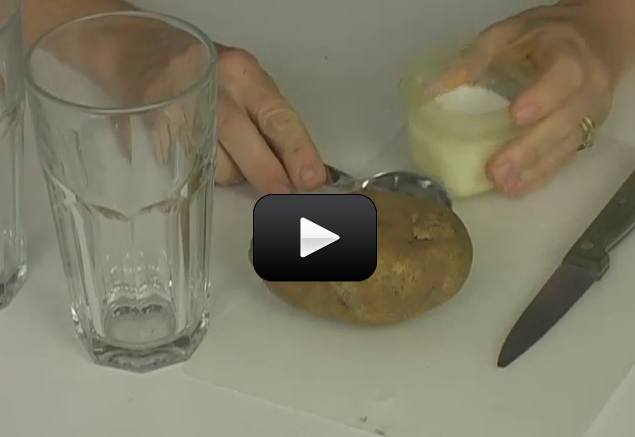One way substances can get into a cell is called passive transport. One special kind of passive transport is osmosis, when water crosses into the cell. This experiment allows you to see the process of osmosis in action. Are you ready?
Please login or register to read the rest of this content.


<<<<<<<<<<<the salt water potato i meant
When i did this for fifteen minutes the potato grew but the second time it was smaller then when I first cut it
That’s a bit confusing Lol
Thsnks
Ps: this is my last day of science!
Okay thank you.
No – just follow the video directions and it will work just fine.
Do the potatoes need to be peeled?
Yes, saltwater does help! You can also try adding vinegar to the saltwater for one batch versus adding baking soda to saltwater for another batch. Let us know which one of those you prefer!
We conclude that the potato in the salt water makes a far better and crispier chip than the potato in the fresh water. 🙂
Osmosis is the diffusion of water molecules through a membrane, where the water molecules move from high water concentration to areas of low water concentration.
Salt starts osmosis by attracting water and causing the water to move toward and across the membrane. Remember that salt is a solute, and when water is added to a solute, it spreads out (diffuses) the concentration of salt, and that creates a chemical solution.
Imagine the salt concentration inside a cell being the exact same as the salt concentration outside the cell – what would happen? Right – the water level will stay the same and nothing would happen. Now imagine there’s more salt inside of a cell than outside it. What happens now? The water moves through the membrane into the cell causing it to swell with water.
If the cell is placed in a higher concentration of salt (like sticking a carrot in a salt bath), the water will leave the cell, and that’s why the plant cells shrink and wilt. This is also why salt kills plants, becaise it takes water from the cells. This doesn’t just happen in plants, though. Animals can also get dehydrated if they drink ocean water.
Water in cells moves toward the highest concentration of salt. I’ll check the text reading to see if there’s a typo.
The reading says that in osmosis the flow is from high concentration to low consentration but that is not what the potato experiment shows. the water goes from the potato to the high salt concentration in the cup. so is this truly osmosis and why doesnt the salt water go into the potato?
Let’s look at the potato first:
The cells in the potato are surrounded by a membrane that acts like your skin does, keeping the cell parts inside and other things outside to protect it. The membrane can stop most things, water being one of the exceptions. If the water is saltier outside the cell than inside, the water moves from the inside to the outside of the cell, leaving the potato or beans like a deflated balloon. The more water that moves out of the cells, the more soft and flexible the vegetable gets.
Okay now for the beans… why do they get larger after being in the water? Beans absorb water (hot water more quickly than cold) and they increase their volume as the water crosses the membrane to go from the outside of the cell to the inside. The dried beans had very little water inside them at first, like a dry sponge, so the water moved to the inside of the beans. If the water is salty, then the water starts to move back out of the beans in the same way it did for the potato.
Why did the beans in the salt water expand less than the beans in the pure water?
Hi i haven’t seen what is supposed to happen when you change the potatoes out for beans. Am I missing something?
Thanks,
Carson
Hi Aurora,
In the video you said the salt water potato expanded, while my results showed that it shrunk. Also in the carrot osmosis experiment you said it shrunk. Also in my experiment they weighed less at the end. Is the salt potato supposed to expand or shrink? I’m a bit confused!
Thank you!
Juliette (13)
I think the salt one got some water out of it and the regular water one grew because it absorbed some water
Cameron, age 13
Cool… you’ve stumbled on another experiment. This one is not really about osmosis, but about cell structure. Cells are surrounded by a cell membrane. The membrane controls what goes into or out of cells. It’s often called the cell’s gatekeeper. Now, when salt starts to enter the potato in the saltwater, it destroys the cell membrane. This makes it easier for things, like the natural coloring of the beans, to enter the cells of the potato. And, voila, purple potatoes. If you want to keep the experiment going, try adding the purple potatoes to fresh water. Thinking about diffusion, what do you think will happen? Try it and let me know if your hypothesis was right.
Hi Aurora, When we did this experiment, we left the potatoes in the water and added the beans overnight. By morning the potato in the salt water was really bendy, but it also was purple. If the water in the cells is leaving and moving to the salt water, how did the cells absorb more of the purple bean color than the potato in the plain water? Thanks, Kylie.